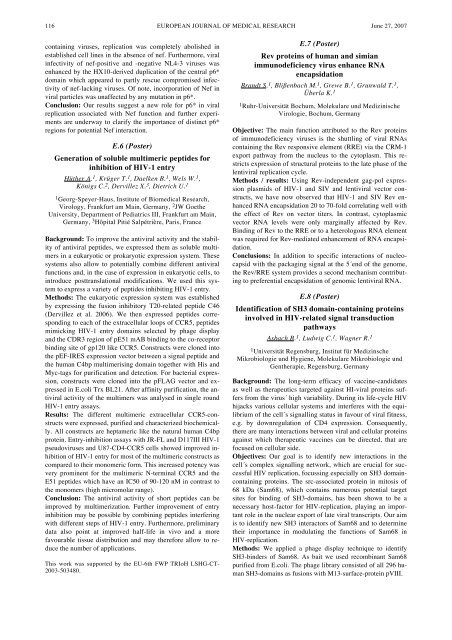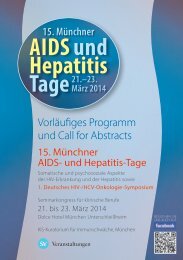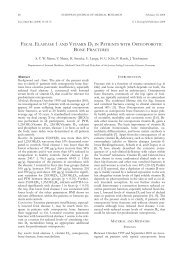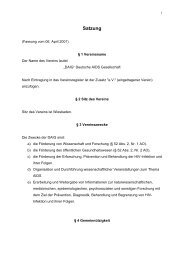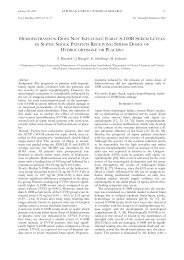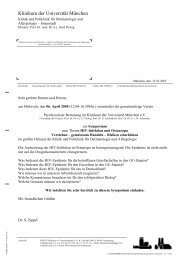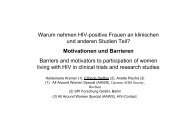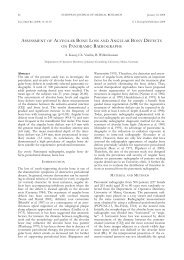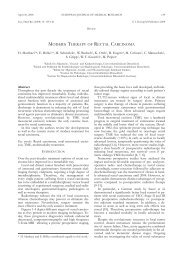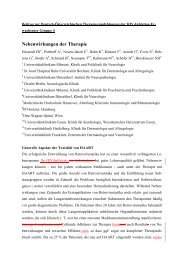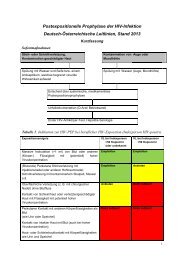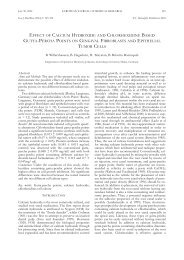European Journal of Medical Research - Deutsche AIDS ...
European Journal of Medical Research - Deutsche AIDS ...
European Journal of Medical Research - Deutsche AIDS ...
You also want an ePaper? Increase the reach of your titles
YUMPU automatically turns print PDFs into web optimized ePapers that Google loves.
116 EUROPEAN JOURNAL OF MEDICAL RESEARCH<br />
June 27, 2007<br />
containing viruses, replication was completely abolished in<br />
established cell lines in the absence <strong>of</strong> nef. Furthermore, viral<br />
infectivity <strong>of</strong> nef-positive and -negative NL4-3 viruses was<br />
enhanced by the HX10-derived duplication <strong>of</strong> the central p6*<br />
domain which appeared to partly rescue compromised infectivity<br />
<strong>of</strong> nef-lacking viruses. Of note, incorporation <strong>of</strong> Nef in<br />
viral particles was unaffected by any mutation in p6*.<br />
Conclusion: Our results suggest a new role for p6* in viral<br />
replication associated with Nef function and further experiments<br />
are underway to clarify the importance <strong>of</strong> distinct p6*<br />
regions for potential Nef interaction.<br />
E.6 (Poster)<br />
Generation <strong>of</strong> soluble multimeric peptides for<br />
inhibition <strong>of</strong> HIV-1 entry<br />
Hüther A. 1 , Krüger T. 1 , Daelken B. 1 , Wels W. 1 ,<br />
Königs C. 2 , Dervillez X. 3 , Dietrich U. 1<br />
1 Georg-Speyer-Haus, Institute <strong>of</strong> Biomedical <strong>Research</strong>,<br />
Virology, Frankfurt am Main, Germany, 2 JW Goethe<br />
University, Department <strong>of</strong> Pediatrics III, Frankfurt am Main,<br />
Germany, 3 Hôpital Pitié Salpétrière, Paris, France<br />
Background: To improve the antiviral activity and the stability<br />
<strong>of</strong> antiviral peptides, we expressed them as soluble multimers<br />
in a eukaryotic or prokaryotic expression system. These<br />
systems also allow to potentially combine different antiviral<br />
functions and, in the case <strong>of</strong> expression in eukaryotic cells, to<br />
introduce posttranslational modifications. We used this system<br />
to express a variety <strong>of</strong> peptides inhibiting HIV-1 entry.<br />
Methods: The eukaryotic expression system was established<br />
by expressing the fusion inhibitory T20-related peptide C46<br />
(Dervillez et al. 2006). We then expressed peptides corresponding<br />
to each <strong>of</strong> the extracellular loops <strong>of</strong> CCR5, peptides<br />
mimicking HIV-1 entry domains selected by phage display<br />
and the CDR3 region <strong>of</strong> pE51 mAB binding to the co-receptor<br />
binding site <strong>of</strong> gp120 like CCR5. Constructs were cloned into<br />
the pEF-IRES expression vector between a signal peptide and<br />
the human C4bp multimerising domain together with His and<br />
Myc-tags for purification and detection. For bacterial expression,<br />
constructs were cloned into the pFLAG vector and expressed<br />
in E.coli Trx BL21. After affinity purification, the antiviral<br />
activity <strong>of</strong> the multimers was analysed in single round<br />
HIV-1 entry assays.<br />
Results: The different multimeric extracellular CCR5-constructs<br />
were expressed, purified and characterized biochemically.<br />
All constructs are heptameric like the natural human C4bp<br />
protein. Entry-inhibition assays with JR-FL and D117III HIV-1<br />
pseudoviruses and U87-CD4-CCR5 cells showed improved inhibition<br />
<strong>of</strong> HIV-1 entry for most <strong>of</strong> the multimeric constructs as<br />
compared to their monomeric form. This increased potency was<br />
very prominent for the multimeric N-terminal CCR5 and the<br />
E51 peptides which have an IC50 <strong>of</strong> 90-120 nM in contrast to<br />
the monomers (high micromolar range).<br />
Conclusion: The antiviral activity <strong>of</strong> short peptides can be<br />
improved by multimerization. Further improvement <strong>of</strong> entry<br />
inhibition may be possible by combining peptides interfering<br />
with different steps <strong>of</strong> HIV-1 entry. Furthermore, preliminary<br />
data also point at improved half-life in vivo and a more<br />
favourable tissue distribution and may therefore allow to reduce<br />
the number <strong>of</strong> applications.<br />
This work was supported by the EU-6th FWP TRIoH LSHG-CT-<br />
2003-503480.<br />
E.7 (Poster)<br />
Rev proteins <strong>of</strong> human and simian<br />
immunodeficiency virus enhance RNA<br />
encapsidation<br />
Brandt S. 1 , Blißenbach M. 1 , Grewe B. 1 , Grunwald T. 1 ,<br />
Überla K. 1<br />
1 Ruhr-Universität Bochum, Molekulare und Medizinische<br />
Virologie, Bochum, Germany<br />
Objective: The main function attributed to the Rev proteins<br />
<strong>of</strong> immunodeficiency viruses is the shuttling <strong>of</strong> viral RNAs<br />
containing the Rev responsive element (RRE) via the CRM-1<br />
export pathway from the nucleus to the cytoplasm. This restricts<br />
expression <strong>of</strong> structural proteins to the late phase <strong>of</strong> the<br />
lentiviral replication cycle.<br />
Methods / results: Using Rev-independent gag-pol expression<br />
plasmids <strong>of</strong> HIV-1 and SIV and lentiviral vector constructs,<br />
we have now observed that HIV-1 and SIV Rev enhanced<br />
RNA encapsidation 20 to 70-fold correlating well with<br />
the effect <strong>of</strong> Rev on vector titers. In contrast, cytoplasmic<br />
vector RNA levels were only marginally affected by Rev.<br />
Binding <strong>of</strong> Rev to the RRE or to a heterologous RNA element<br />
was required for Rev-mediated enhancement <strong>of</strong> RNA encapsidation.<br />
Conclusions: In addition to specific interactions <strong>of</strong> nucleocapsid<br />
with the packaging signal at the 5´end <strong>of</strong> the genome,<br />
the Rev/RRE system provides a second mechanism contributing<br />
to preferential encapsidation <strong>of</strong> genomic lentiviral RNA.<br />
E.8 (Poster)<br />
Identification <strong>of</strong> SH3 domain-containing proteins<br />
involved in HIV-related signal transduction<br />
pathways<br />
Asbach B. 1 , Ludwig C. 1 , Wagner R. 1<br />
1 Universität Regensburg, Institut für Medizinsche<br />
Mikrobiologie und Hygiene, Molekulare Mikrobiologie und<br />
Gentherapie, Regensburg, Germany<br />
Background: The long-term efficacy <strong>of</strong> vaccine-candidates<br />
as well as therapeutics targeted against HI-viral proteins suffers<br />
from the virus´ high variability. During its life-cycle HIV<br />
hijacks various cellular systems and interferes with the equilibrium<br />
<strong>of</strong> the cell´s signalling status in favour <strong>of</strong> viral fitness,<br />
e.g. by downregulation <strong>of</strong> CD4 expression. Consequently,<br />
there are many interactions between viral and cellular proteins<br />
against which therapeutic vaccines can be directed, that are<br />
focused on cellular side.<br />
Objectives: Our goal is to identify new interactions in the<br />
cell´s complex signalling network, which are crucial for successful<br />
HIV replication, focussing especially on SH3 domaincontaining<br />
proteins. The src-associated protein in mitosis <strong>of</strong><br />
68 kDa (Sam68), which contains numerous potential target<br />
sites for binding <strong>of</strong> SH3-domains, has been shown to be a<br />
necessary host-factor for HIV-replication, playing an important<br />
role in the nuclear export <strong>of</strong> late viral transcripts. Our aim<br />
is to identify new SH3 interactors <strong>of</strong> Sam68 and to determine<br />
their importance in modulating the functions <strong>of</strong> Sam68 in<br />
HIV-replication.<br />
Methods: We applied a phage display technique to identify<br />
SH3-binders <strong>of</strong> Sam68. As bait we used recombinant Sam68<br />
purified from E.coli. The phage library consisted <strong>of</strong> all 296 human<br />
SH3-domains as fusions with M13-surface-protein pVIII.


